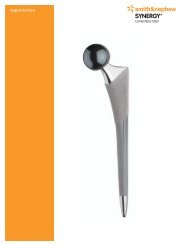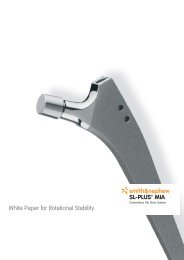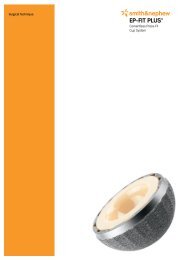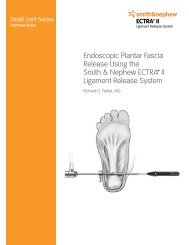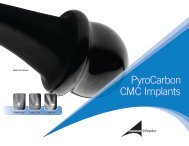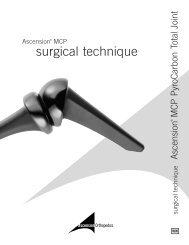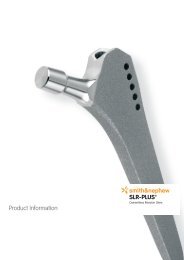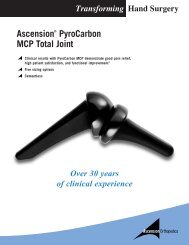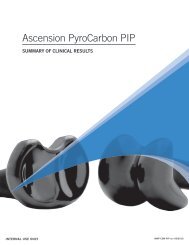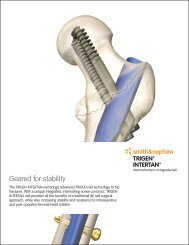7138-0658 Basis hip brochure 1.2.qxp
7138-0658 Basis hip brochure 1.2.qxp
7138-0658 Basis hip brochure 1.2.qxp
You also want an ePaper? Increase the reach of your titles
YUMPU automatically turns print PDFs into web optimized ePapers that Google loves.
Surgical Technique
BASIS Femoral Implant System<br />
Surgical Technique<br />
Contents<br />
Design Features ..........................................................................2<br />
Short Technique ..........................................................................3<br />
Catalog Information ....................................................................6<br />
Important Medical Information....................................................8<br />
Nota Bene: The technique description herein is made available to the<br />
healthcare professional to illustrate the authors’ suggested treatment<br />
for the uncomplicated procedure. In the final analysis, the preferred<br />
treatment is that which addresses the needs of the patient.
Design Features<br />
Morse-Type Taper<br />
An optimized 12/14 taper offers<br />
increased neck length adjustability<br />
and a greater number of skirtless<br />
heads that decrease incidence of<br />
early impingement.<br />
Proximal Driving Platform<br />
Minimizes damage to head/neck<br />
while the insertion forces are directed<br />
along the longitudinal axis. Provides<br />
version control for neutral stem<br />
position and appropriate anteversion.<br />
Circulotrapezoidal Neck<br />
Optimizing neck geometry<br />
increases range of motion. By<br />
using more material in the<br />
medial/lateral direction, where<br />
bending moments are higher and<br />
less material in the<br />
anterior/posterior direction, where<br />
the loads are smaller, the range of<br />
motion is maximized. The<br />
optimized neck geometry is<br />
circulotrapezoidal.<br />
BASIS Profile<br />
Provides medial cement compression<br />
for longer cement mantle survival.<br />
Cement is stronger in compression<br />
than tension.<br />
Broad 50º Collar<br />
Anatomic calcar load angle facilitates<br />
collar/calcar contact which provides<br />
physiological stress distribution.<br />
Improves cement compression upon<br />
insertion of the stem and helps<br />
centralize the stem in the canal.<br />
Broad Medial and<br />
Lateral Surface Areas<br />
Reduces maximum cement stresses<br />
to help increase cement mantle<br />
longevity.<br />
Tapered Distal Stem<br />
Distributes stresses over the full<br />
length of the stem and enhances the<br />
compressive load of the cement;<br />
thus, minimizes peak cement<br />
stresses.<br />
Distal Centralizer<br />
Neutralizes stem in the canal while<br />
maintaining a complete cement<br />
mantle.<br />
2
Short Technique<br />
Step 1<br />
Osteotomize the femoral neck.<br />
Step 2<br />
Open the femoral canal with a box<br />
chisel and a blunt medullary reamer.<br />
Step 3<br />
Broach the femur. Stay lateral and<br />
posterior.<br />
3
Step 4<br />
Plane the calcar.<br />
Step 5<br />
Perform a trial reduction.<br />
Step 6<br />
Place the BUCK plug. Brush, lavage,<br />
and dry the femoral canal.<br />
Stem BUCK Cement Restrictor<br />
Size Insertion Depth (mm)<br />
1 140<br />
2 150<br />
3 160<br />
4 160<br />
5 160<br />
3
Step 7<br />
Retrograde fill the femoral canal with<br />
cement and pressurize.<br />
Step 8<br />
Add the distal centralizer or distal hole<br />
plug. Insert the same stem size as the<br />
final broach.<br />
Step 9<br />
Assemble the femoral head.<br />
5
Catalog Information<br />
BASIS 12/14 Taper<br />
Primary Collared Stems<br />
Cobalt Chromium-ASTM F 75<br />
Stem<br />
Size Length Cat. No.<br />
1 115mm 7131-2261<br />
2 125mm 7131-2262<br />
3 135mm 7131-2263<br />
4 135mm 7131-2264<br />
5 135mm 7131-2265<br />
OXINIUM Femoral Heads 12/14 Taper<br />
Neck<br />
Length 28mm 32mm 36mm<br />
–3 7134-2803 7134-3203 7134-3603<br />
+0 7134-2800 7134-3200 7134-3600<br />
+4 7134-2804 7134-3204 7134-3604<br />
+8 7134-2808 7134-3208 7134-3608<br />
+12 7134-2812 7134-3212 7134-3612<br />
+16 7134-2816 7134-3216 ––<br />
CoCr 12/14 Taper Femoral Heads Cobalt Chromium-ASTM F 799<br />
Neck<br />
Length 22mm 26mm 28mm 32mm<br />
-3 – – 7130-2803 7130-3203<br />
+0 7132-2200 7130-2600 7130-2800 7130-3200<br />
+4 7132-2204 7130-2604 7130-2804 7130-3204<br />
+8 7132-2208 7130-2608 7130-2808 7130-3208<br />
+12 7132-2212 7130-2612 7130-2812 7130-3212<br />
+16 – – 7130-2816 7130-3216<br />
SPECTRON INVIS Distral Centralizers<br />
Size O.D. Cat. No.<br />
1 8mm 7131-3101<br />
2 9mm 7131-3102<br />
3 10mm 7131-3103<br />
4 12mm 7131-3104<br />
5 13mm 7131-3105<br />
INVIS Distal Centralizers<br />
O.D. Cat. No.<br />
8mm 7131-3208<br />
9mm 7131-3209<br />
10mm 7131-3210<br />
11mm 7131-3211<br />
12mm 7131-3212<br />
13mm 7131-3213<br />
14mm 7131-3214<br />
O.D. Cat. No.<br />
15mm 7131-3215<br />
16mm 7131-3216<br />
17mm 7131-3217<br />
18mm 7131-3218<br />
19mm 7131-3219<br />
20mm 7131-3220<br />
21mm 7131-3221<br />
6
SPECTRON EF 12/14 Taper Sterilization Tray<br />
Cat. No. 7136-9113<br />
Trial 12/14 Taper Femoral Heads<br />
Neck Color<br />
Length Code 22mm 26mm 28mm 32mm 36mm<br />
-3 Green – – 7135-2803 7135-3203 7134-3603<br />
+0 Yellow 7135-2200 7135-2600 7135-2800 7135-3200 7134-3600<br />
+4 Red 7135-2204 7135-2604 7135-2804 7135-3204 7134-3604<br />
+8 White 7135-2208 7135-2608 7135-2808 7135-3208 7134-3608<br />
+12 Blue 7135-2212 7135-2612 7135-2812 7135-3212 7134-3612<br />
+16 Black – – 7135-2816 7135-3216 –<br />
Broaches / Trials<br />
Cat. No. Size<br />
7136-5001 1<br />
7136-5002 2<br />
7136-5003 3<br />
7136-5004 4<br />
7136-5005 5<br />
Trial Necks<br />
Cat. No. Size<br />
7136-5081 1<br />
7136-5082 2<br />
7136-5083 3<br />
7136-5084 4<br />
7136-5085 5<br />
Osteotomy Guide<br />
Cat. No. 7136-5036 Sizes: 1-5<br />
Box Chisel<br />
Cat. No. 7136-4002<br />
Size: Small<br />
Blunt Medullary Reamer<br />
Cat. No. 11-9657<br />
Broach Handle<br />
Cat. No. 7136-4007<br />
Calcar Reamers<br />
Cat. No. 7136-5023 Sizes: 1-3<br />
Cat. No. 7136-5025 Sizes: 4-5<br />
Anteversion Handle<br />
Cat. No. 7136-4012<br />
Femoral Component Driver<br />
Cat. No. 11-9817<br />
Femoral Head Impactor<br />
Cat. No. 7136-4009<br />
7
Important Medical Information<br />
Warnings and Precautions<br />
Total Hip System<br />
Important Note<br />
Total <strong>hip</strong> replacement (THR) arthroplasty has become a successful<br />
procedure for relieving pain and restoring motion in patients who are<br />
disabled from <strong>hip</strong> arthropathy. The goals of total <strong>hip</strong> replacement are to<br />
decrease pain, increase function, and increase mobility.<br />
Materials<br />
Femoral components are cobalt chromium alloy, titanium 6Al-4V alloy or<br />
stainless steel. Femoral heads are cobalt chromium alloy, zirconia ceramic,<br />
alumina ceramic, OXINIUM oxidized zirconium or stainless steel.<br />
Acetabular liners are ultra-high molecular weight polyethylene or alumina<br />
ceramic. All poly acetabular components are ultra-high molecular weight<br />
polyethylene. Acetabular shells are titanium 6Al-4V alloy. The component<br />
material is provided on the outside carton label.<br />
Note: Ceramic/ceramic implants are not available in the U.S.A.<br />
Some of the alloys needed to produce orthopedic implants contain some<br />
metallic components that may be carcinogenic in tissue cultures or intact<br />
organism under very unique circumstances. Questions have been raised in<br />
the scientific literature as to whether or not these alloys may be<br />
carcinogenic in implant recipients. Studies conducted to evaluate this issue<br />
have not identified conclusive evidence of such phenomenon, in spite of<br />
the millions of implants in use.<br />
Description of System<br />
The Total Hip System consists of femoral components, proximal pads, taper<br />
sleeves, distal sleeves, acetabular components, fixation screws and pegs,<br />
hole covers, centralizers, and femoral heads. Components may be grit<br />
blasted, porous coated, hydroxylapatite (HA) coated, or HA porous coated.<br />
All implantable devices are designed for single use only.<br />
Femoral Components<br />
Femoral components are available in a variety of sizes. Porous coated<br />
components are coated for biological ingrowth. Proximally and distally<br />
modular femoral components accept proximal pads and distal sleeves,<br />
respectively. Non-porous femoral components can feature PMMA<br />
centralizers that help produce a uniform thickness of cement.<br />
Femoral components are available with a Small (10/12), Large (14/16), or<br />
12/14 global taper.<br />
Small taper femoral components mate and lock directly with a 22mm metal,<br />
oxidized zirconium or ceramic head. The Small taper also mates with a<br />
taper sleeve which, in turn, mates with either metal or ceramic heads (26,<br />
28, or 32mm), bipolar or unipolar components.<br />
Large taper femoral components mate and lock with either metal heads<br />
(26, 28, or 32mm), ceramic heads (28 or 32mm), oxidized zirconium (28,<br />
32, or 36mm), bipolars or unipolar components.<br />
Femoral components with a 12/14 taper mate and lock with either metal<br />
heads, oxidized zirconium heads, ceramic heads, bipolar or unipolar<br />
components.<br />
Small, Large, and 12/14 taper femoral component tapers are machined to<br />
mate and lock with ceramic heads, thus preventing rotation of the ceramic<br />
head on the stem, which would cause wear of the stem taper.<br />
Taper Sleeves<br />
A taper sleeve is required to be impacted on the Small taper femoral<br />
component prior to impacting a Large (14/16) taper femoral head size 26,<br />
28, or 32mm. A taper sleeve is required to attach a unipolar head. Unipolar<br />
taper sleeves are available in Small, Large, and 12/14 tapers. Never place<br />
more than one taper sleeve on a femoral component.<br />
Femoral Heads<br />
Cobalt chromium, stainless steel, oxidized zirconium, and ceramic heads<br />
are available in multiple neck lengths for proper anatomic and musculature<br />
fit. Heads are highly polished for reduced friction and wear. The following<br />
zirconia ceramic heads are available for use only with Small and Large<br />
taper femoral components:<br />
Zirconia Head Neck Length<br />
Ceramic Diameter<br />
42-7815 32mm Standard 0mm<br />
42-7816 32mm Long + 4mm<br />
42-7817 32mm X-Long + 8mm<br />
42-7818 28mm Standard 0mm<br />
42-7819 28mm Long + 4mm<br />
42-7820 28mm X-Long + 8mm<br />
Note: 32mm heads with a -3mm neck length are not available for use with<br />
the Small taper stems.<br />
In addition to the components listed above, the following components are<br />
available for use only with Small taper femoral components:<br />
Zirconia Head Neck Length<br />
Ceramic Diameter<br />
7132-0002 22mm Long + 4mm<br />
7132-0006 22mm X-Long + 8mm<br />
Note: 22mm Zirconia Ceramic Heads used with Small taper femoral<br />
components are not available in the U.S.A.<br />
The following zirconia ceramic heads are available for use only with 12/14<br />
taper femoral components:<br />
Zirconia Head Neck Length<br />
Ceramic Diameter<br />
7132-0028 28mm Standard 0mm<br />
7132-0428 28mm Long + 4mm<br />
7132-0828 28mm X-Long + 8mm<br />
7132-0026 26mm Standard 0mm<br />
7132-0426 26mm Long + 4mm<br />
7132-0826 26mm X-Long + 8mm<br />
7132-0422 22mm Long + 4mm<br />
7132-0822 22mm X-Long + 8mm<br />
The following alumina ceramic heads are available for use only with 12/14<br />
taper femoral components:<br />
Alumina Head Neck Length<br />
Ceramic Diameter<br />
7133-2800 28mm Standard 0mm<br />
7133-2804 28mm Long + 4mm<br />
7133-2808 28mm X-Long + 8mm<br />
7133-3200 32mm Standard 0mm<br />
7133-3204 32mm Long + 4mm<br />
7133-3208 32mm X-Long + 8mm<br />
7133-3600 36mm Standard 0mm<br />
7133-3604 36mm Long + 4mm<br />
7133-3608 36mm X-Long + 8mm<br />
Acetabular Components<br />
Acetabular components can be one piece all polyethylene, two-piece<br />
component consisting of a titanium shell and a polyethylene liner or a<br />
titanium shell and an alumina ceramic liner. Please see Warnings and<br />
Precautions for specific information on screws, pegs and hole covers use.<br />
Acetabular reinforcement and reconstruction rings are used with an all<br />
polyethylene acetabular component. Note: The metal shell and ceramic<br />
liner in the Ceramic/Ceramic Acetabular System are not available in the<br />
U.S.A.<br />
The BIRMINGHAM HIP Resurfacing (BHR) prosthesis is a metal-on-metal<br />
bearing component consisting of a stemmed femoral head resurfacing<br />
component designed for cemented insertion and a hemispherical<br />
acetabular cup designed for cementless interference fit into the<br />
acetabulum. The acetabular cup has hydroxylapatite coating applied to the<br />
external surface and porous coating. Cement should not be used with this<br />
type of implant. Note: The BHR prosthesis is not available in the U.S.A.<br />
Note: 10 Mrad cross-linked polyethylene (UHMWPE) REFLECTION<br />
Acetabular Liners may be used with metal (CoCr), oxidized zirconium,<br />
alumina ceramic or zirconia ceramic femoral heads.<br />
Femoral components and femoral heads are designed for use with any<br />
Smith & Nephew polyethylene acetabular component or polyethylenelined,<br />
metal-backed acetabular component having an appropriately-sized<br />
inside diameter.<br />
INDICATIONS, CONTRAINDICATIONS, AND ADVERSE EFFECTS<br />
Hip components are indicated for individuals undergoing primary and<br />
revision surgery where other treatments or devices have failed in<br />
rehabilitating <strong>hip</strong>s damaged as a result of trauma or noninflammatory<br />
degenerative joint disease (NIDJD) or any of its composite diagnoses of<br />
osteoarthritis, avascular necrosis, traumatic arthritis, slipped capital<br />
epiphysis, fused <strong>hip</strong>, fracture of the pelvis, and diastrophic variant.<br />
Hip components are also indicated for inflammatory degenerative joint<br />
disease including rheumatoid arthritis, arthritis secondary to a variety of<br />
diseases and anomalies, and congenital dysplasia; old, remote<br />
osteomyelitis with an extended drainage-free period, in which case, the<br />
patient should be warned of an above normal danger of infection<br />
postoperatively; treatments of nonunion, femoral neck fracture and<br />
trochanteric fractures of the proximal femur with head involvement that are<br />
unmanageable using other techniques; endoprosthesis, femoral osteotomy,<br />
or Girdlestone resection; fracture-dislocation of the <strong>hip</strong>; and correction of<br />
deformity.<br />
The BIRMINGHAM HIP Resurfacing (BHR) arthroplasty system is indicated<br />
for use for reduction or relief of pain and/or improved <strong>hip</strong> function in<br />
patients who are candidates for a total <strong>hip</strong> replacement but who have<br />
evidence of good femoral bone stock. These patients should also be<br />
skeletally mature with the following conditions: noninflammatory<br />
degenerative joint disease such as osteoarthritis, avascular necrosis,<br />
ankylosis, protrusio acetabuli, and painful <strong>hip</strong> dysplasia; inflammatory<br />
degenerative joint disease such as rheumatoid arthritis; correction of<br />
functional deformity; and are of an age such that total <strong>hip</strong> revision is likely<br />
at some future point.<br />
Acetabular reinforcement and reconstruction rings are intended to be used<br />
in primary and revision surgeries where the acetabulum has the<br />
deficiencies of the acetabular roof, anterior or posterior pillar, medial wall<br />
deficiency, and / or protrusion as a result of the indications listed<br />
previously.<br />
Some of the diagnoses listed above and below may also increase the<br />
chance of complications and reduce the chance of a satisfactory result.<br />
Contraindications<br />
1. Conditions that would eliminate or tend to eliminate adequate implant<br />
support or prevent the use of an appropriately-sized implant, e.g.:<br />
a. blood supply limitations;<br />
b. insufficient quantity or quality of bone support, e.g., osteoporosis, or<br />
metabolic disorders which may impair bone formation, and<br />
osteomalacia; and<br />
c. infections or other conditions which lead to increased bone<br />
resorption.<br />
2. Mental or neurological conditions which tend to impair the patient's<br />
ability or willingness to restrict activities.<br />
3. Physical conditions or activities which tend to place extreme loads on<br />
implants, e.g., Charcot joints, muscle deficiencies, multiple joint<br />
disabilities, etc.<br />
4. Skeletal immaturity.<br />
5. The zirconia ceramic head is contraindicated for use with any other<br />
product than an UHMW polyethylene cup or a metal backed UHMW<br />
polyethylene cup.<br />
6. The alumina ceramic liner is contraindicated for use with any product<br />
other than the metal shell with the correlating inner taper geometry and<br />
the appropriate sized alumina ceramic head. The alumina ceramic liner<br />
should only be used with the alumina ceramic head.<br />
Contraindications may be relative or absolute and must be carefully<br />
weighed against the patient's entire evaluation and the prognosis for<br />
possible alternative procedures such as non-operative treatment,<br />
arthrodesis, femoral osteotomy, pelvic osteotomy, resection arthroplasty,<br />
hemiarthroplasty and others. Conditions presenting increased risk of failure<br />
include: osteoporosis, metabolic disorders which may impair bone<br />
formation, and osteomalacia.<br />
Possible Adverse Effects<br />
1. Wear of the polyethylene and ceramic articulating surfaces of<br />
acetabular components may occur. Higher rates of wear may be<br />
initiated by the presence of particles of cement, metal, or other debris<br />
which can develop during or as a result of the surgical procedure and<br />
cause abrasion of the articulating surfaces. Higher rates of wear may<br />
shorten the useful life of the prosthesis and lead to early revision<br />
surgery to replace the worn prosthetic components.<br />
2. With all joint replacements, asymptomatic, localized, progressive bone<br />
resorption (osteolysis) may occur around the prosthetic components as<br />
a consequence of foreign-body reaction to particulate wear debris.<br />
Particles are generated by interaction between components, as well as<br />
between the components and bone, primarily through wear<br />
mechanisms of adhesion, abrasion, and fatigue. Secondarily, particles<br />
may also be generated by third-body particles lodged in the<br />
polyethylene or ceramic articular surfaces. Osteolysis can lead to future<br />
complications necessitating the removal or replacement of prosthetic<br />
components.<br />
3. Loosening, bending, cracking, or fracture of implant components may<br />
result from failure to observe the Warnings and Precautions below.<br />
Fracture of the implant can occur as a result of trauma, strenuous<br />
activity, improper alignment, or duration of service.<br />
4. Dislocations, subluxation, decreased range of motion, or lengthening or<br />
shortening of the femur caused by improper neck selection,<br />
positioning, looseness of acetabular or femoral components,<br />
extraneous bone, penetration of the femoral prosthesis through the<br />
shaft of the femur, fracture of the acetabulum, intrapelvic protrusion of<br />
acetabular component, femoral impingement, periarticular calcification,<br />
and/or excessive reaming.<br />
5. Fracture of the pelvis or femur: post-operative pelvic fractures are<br />
usually stress fractures. Femoral fractures are often caused by defects<br />
in the femoral cortex due to misdirected reaming, etc. Intraoperative<br />
fractures are usually associated with old congenital deformity, improper<br />
stem selection, improper broaching, and/or severe osteoporosis.<br />
6. Infection, both acute post-operative wound infection and late deep<br />
wound sepsis.<br />
7. Neuropathies; femoral, sciatic, peroneal nerve, and lateral femoral<br />
cutaneous neuropathies have been reported. Temporary or permanent<br />
nerve damage resulting in pain or numbness of the affected limb.<br />
8. Wound hematoma, thromboembolic disease including venous<br />
thrombosis, pulmonary embolus, or myocardial infarction.<br />
9. Myositis ossificans, especially in males with hypertrophic arthritis,<br />
limited pre-operative range of motion and/or previous myositis. Also,<br />
periarticular calcification with or without impediment to joint mobility<br />
can cause decreased range of motion.<br />
10. Trochanteric nonunion usually associated with early weight bearing<br />
and/or improper fixation of the trochanter, when a transtrochanteric<br />
surgical approach is used.<br />
11. Although rare, metal sensitivity reactions and/or allergic reactions to<br />
foreign materials have been reported in patients following joint<br />
replacement.<br />
12. Damage to blood vessels.<br />
13. Traumatic arthrosis of the knee from intraoperative positioning of the<br />
extremity.<br />
14. Delayed wound healing.<br />
15. Aggravated problems of the affected limb or contralateral extremity<br />
caused by leg length discrepancy, excess femoral medialization, or<br />
muscle deficiency.<br />
16. Failure of the porous coating/ substrate interface or hydroxylapatite<br />
coating/ porous coating bonding may result in bead separation<br />
delamination.<br />
17. Stem migration or subsidence has occurred in conjunction with<br />
compaction grafting procedures usually resulting from insufficient graft<br />
material or improper cement techniques. Varus stem alignment may<br />
also be responsible.<br />
Warnings and Precautions<br />
The patient should be warned of surgical risks, and made aware of<br />
possible adverse effects. The patient should be warned that the device<br />
does not replace normal healthy bone, that the implant can break or<br />
become damaged as a result of strenuous activity or trauma, and that it<br />
has a finite expected service life and may need to be replaced in the<br />
future. Do not mix components from different manufacturers. Additional<br />
Warnings and Precautions may be included in component literature.<br />
8
Preoperative<br />
1. Use extreme care in handling and storage of implant components.<br />
Cutting, bending, or scratching the surface of components can<br />
significantly reduce the strength, fatigue resistance, and/or wear<br />
characteristics of the implant system. These, in turn, may induce<br />
internal stresses that are not obvious to the eye and may lead to fracture<br />
of the component. Implants and instruments should be protected from<br />
corrosive environments such as salt air during storage. Do not allow the<br />
porous surfaces to come in contact with cloth or other fiber-releasing<br />
materials.<br />
2. Allergies and other reactions to device materials, although infrequent,<br />
should be considered, tested for (if appropriate), and ruled out<br />
preoperatively.<br />
3. Fixation and expected longevity of components expected to be left in<br />
place at revision surgery should be thoroughly assessed.<br />
4. Surgical technique information is available upon request. The surgeon<br />
should be familiar with the technique. Refer to medical or manufacturer<br />
literature for specific product information.<br />
5. Intraoperative fracture or breaking of instruments can occur. Instruments<br />
which have experienced extensive use or excessive force are<br />
susceptible to fracture. Instruments should be examined for wear, or<br />
damage, prior to surgery.<br />
6. Do not cold water quench ceramic components and never sterilize<br />
ceramic heads while fixed on the stem taper. (See sterilization section,<br />
below.)<br />
7. Select components such that the zirconia ceramic and oxidized<br />
zirconium heads always articulate with a UHMW polyethylene cup or a<br />
metal backed UHMW polyethylene cup and alumina heads articulate<br />
with UHMW polyethylene or alumina liners. Zirconia ceramic, oxidized<br />
zirconium, and alumina heads should never articulate against metal<br />
because severe wear of the metal will occur.<br />
8. Select only Smith & Nephew femoral components that indicate their use<br />
with ceramic heads. This is important because the taper on the stem is<br />
machined to tightly mate and lock with the ceramic head thus<br />
preventing rotation of the ceramic head on the stem. Also, an<br />
improperly dimensioned taper could result in fracture of the ceramic<br />
head.<br />
9. The zirconia ceramic head is composed of a new ceramic material with<br />
limited clinical history. Although mechanical testing demonstrates that<br />
when used with a polyethylene acetabular component the yttria<br />
stabilized zirconia ball produces a relatively low amount of particulates,<br />
the total amount of particulate remains undetermined. Because of the<br />
limited clinical and preclinical experience, the biological effect of these<br />
particulates can not be predicted.<br />
10. Alumina ceramic should never articulate against metal because severe<br />
wear could occur.<br />
11. If a computer assisted surgery system is used, consult the applicable<br />
software and hardware reference manuals provided by the<br />
manufacturer to ensure proper operation of this equipment.<br />
Intraoperative<br />
1. The general principles of patient selection and sound surgical judgment<br />
apply. The correct selection of the implant is extremely important. The<br />
appropriate type and size should be selected for patients with<br />
consideration of anatomical and biomechanical factors such as patient<br />
age and activity levels, weight, bone and muscle conditions, any prior<br />
surgery and anticipated future surgeries, etc. Generally, the largest<br />
cross-section component which will allow adequate bone support to be<br />
maintained is preferred. Failure to use the optimum-sized component<br />
may result in loosening, bending, cracking, or fracture of the component<br />
and/or bone.<br />
2. Correct selection of the neck length and cup, and stem positioning, are<br />
important. Muscle looseness and/or malpositioning of components<br />
may result in loosening, subluxation, dislocation, and/or fracture of<br />
components. Increased neck length and varus positioning will increase<br />
stresses which must be borne by the stem. The component should be<br />
firmly seated with the component insertion instruments.<br />
3. Care should be taken not to scratch, bend (with the exception of the<br />
Reconstruction Rings) or cut implant components during surgery for the<br />
reasons stated in Number One of the "Pre-Operative" section of<br />
"Warnings and Precautions."<br />
4. A +12mm or +16mm femoral head should not be used with any Small<br />
taper stems.<br />
5. Distal sleeves should not be used to bridge cortical defects that lie<br />
within 25mm of the tip of the base stem.<br />
6. MATRIX Small taper stem sizes 8S - 10L must have a minimum neck<br />
length of +8mm when used with a bipolar component; and Small taper<br />
stem sizes 12S - 16L must have a minimum neck length of +4mm when<br />
used with a bipolar component.<br />
7. Modular heads and femoral components should be from the same<br />
manufacturer to prevent mismatch of tapers.<br />
8. Stainless steel heads and stainless steel stems should only be used<br />
together. Neither should be used with other metal components.<br />
9. Use only REFLECTION Liners with REFLECTION Shells.<br />
10. Clean and dry stem taper prior to impacting the femoral head or taper<br />
sleeve. The modular femoral head component must be firmly seated on<br />
the femoral component to prevent disassociation.<br />
11. Take care, when positioning and drilling screw and peg holes, to avoid<br />
penetration of the inner cortex of the pelvis, penetration of the sciatic<br />
notch, or damage to vital neurovascular structures. Perforation of the<br />
pelvis with screws that are too long can rupture blood vessels causing<br />
the patient to hemorrhage. Do not place a screw in the center hole of<br />
the acetabular prosthesis. Placement of drills and screws in the anterior<br />
or medial portions of the prosthesis is associated with a high risk of<br />
potentially fatal vascular injury. Bone screws must be completely seated<br />
in the holes of the shell to allow proper locking for the acetabular<br />
component liner. If the tapered pegs need to be removed from the shell<br />
after impaction of the pegs, do not reuse the pegs or the peg shell<br />
holes. Use new pegs and different shell holes, or a new shell if<br />
necessary.<br />
12. USE ONLY REFLECTION TITANIUM SPHERICAL HEAD BONE SCREWS,<br />
UNIVERSAL CANCELLOUS BONE SCREWS, TAPERED PEGS, AND HOLE<br />
COVERS with the REFLECTION Acetabular Components. REFLECTION<br />
SP3, FSO and INTERFIT Shells accept both REFLECTION spherical head<br />
screws and Universal cancellous bone screws. REFLECTION FSO and<br />
INTERFIT Shells accept the Modified REFLECTION screw hole covers. The<br />
REFLECTION V Shell only accepts Universal Cancellous, REFLECTION<br />
screws, and tapered screw-hole covers, not pegs. REFLECTION<br />
Peripheral Hole Screws should only be used with REFLECTION<br />
Peripheral Hole Shells. Locking Head Pegs and REFLECTION SP Screw<br />
Hole Covers are only for use with SP3 Shells. Tapered pegs can only be<br />
used with REFLECTION V Shells. The threaded center hole in<br />
REFLECTION Shells only accepts the threaded hole cover, not screws or<br />
pegs. The INTERFIT threaded hole cover is only for use with REFLECTION<br />
INTERFIT, SP3, Spiked and No Hole Shells. The REFLECTION threaded<br />
hole cover can be used with all REFLECTION shells. Refer to product<br />
literature for proper adjunctive fixation and hole cover usage.<br />
13. Prior to seating modular components, surgical debris including tissue<br />
must be cleaned from the surfaces. Debris, including bone cement,<br />
may inhibit the component locking mechanism. If the shell is to be<br />
cemented in place, remove extraneous cement with a plastic sculps tool<br />
to ensure proper locking of the liner. During liner insertion, make sure<br />
soft tissue does not interfere with the shell/liner interface. Chilling the<br />
liner reduces the impaction force required to seat the liner. Modular<br />
components must be assembled securely to prevent disassociation.<br />
Debris inhibits the proper fit and locking of modular components which<br />
may lead to early failure of the procedure. Failure to properly seat the<br />
acetabular liner into the shell can lead to disassociation of the liner from<br />
the shell.<br />
14. Avoid repeated assembly and disassembly of the modular components<br />
which could compromise the critical locking action of the locking<br />
mechanism.<br />
15. Care is to be taken to assure complete support of all parts of the device<br />
embedded in bone cement to prevent stress concentration which may<br />
lead to failure of the procedure. During curing of the cement, care<br />
should be taken to prevent movement of the implant components.<br />
16. If the head is removed from a femoral component that will be left in<br />
place at revision surgery, it is recommended that a metal head be used.<br />
A ceramic head may fracture from irregularities on the femoral<br />
component taper.<br />
17. If components are to be left in place at revision surgery, they should first<br />
be thoroughly checked for signs of looseness, etc. and replaced if<br />
necessary. The head/neck component should be changed only when<br />
clinically necessary.<br />
18. Once removed from the patient, implants previously implanted should<br />
never be reused, since internal stresses which are not visible may lead<br />
to early bending or fracture of these components.<br />
19. With the congenitally dislocated <strong>hip</strong>, special care should be taken to<br />
prevent sciatic nerve palsy. Also, note that the femoral canal is often<br />
very small and straight and may require an extra-small straight femoral<br />
prosthesis; however, a regular-sized prosthesis should be used when<br />
possible. Note that the true acetabulum is rudimentary and shallow. A<br />
false acetabulum should not ordinarily be utilized as a cup placement<br />
site for anatomical and biomechanical reasons.<br />
20. With rheumatoid arthritis, especially for those patients on steroids,<br />
bone may be extremely osteoporotic. Care should be taken to prevent<br />
excessive penetration of the acetabular floor or fracture of the medial<br />
acetabular wall, femur, or greater trochanter.<br />
21. Revision procedures for previous arthroplasty, Girdlestone, etc., are<br />
technically demanding and difficult to exercise. Common errors include<br />
misplacement of the incision, inadequate exposure or mobilization of<br />
the femur, inadequate removal of ectopic bone, or improper positioning<br />
of components. Postoperative instability as well as excessive blood loss<br />
can result. In summary, increased operative time, blood loss, increased<br />
incidence of pulmonary embolus and wound hematoma can be<br />
expected with revision procedures.<br />
22. Prior to closure, the surgical site should be thoroughly cleaned of<br />
cement, bone c<strong>hip</strong>s, ectopic bone, etc. Ectopic bone and/or bone spurs<br />
may lead to dislocation or painful or restricted motion. Range of motion<br />
should be thoroughly checked for early contact or instability.<br />
23. Proper positioning of the components is important to minimize<br />
impingement which could lead to early failure, premature wear, and/or<br />
dislocation.<br />
24. In order to minimize the risks of dislocation and loosening of the shellacetabular<br />
bone or shell-bone cement interface that may occur when<br />
using a metallic shell intended for biological fixation or cemented use<br />
only, surgeons should consider providing immediate resistance to<br />
tensile forces between the metallic shell and the acetabular bone or<br />
bone cement interface through the use of orthopedic bone fixation<br />
devices such as bone screws, spikes, screw threads, pegs, fins, or<br />
other bone fixation devices.<br />
25. Physicians should consider component malposition, component<br />
placement, and the effect on range of motion when using modular<br />
heads (with sleeves or skirts) and extended liners.<br />
26. For computer assisted surgery systems, it is extremely important to<br />
correctly select input parameters (e.g. bony landmarks). Operators of<br />
this equipment should be familiar with the anatomy relevant to the<br />
procedure. Failure to provide proper input could cause problems such as<br />
violation of critical anatomical structures and malpositioned implants.<br />
Postoperative<br />
1. Postoperative directions and warnings to patients by physicians, and<br />
patient care, are extremely important. Gradual weight bearing is begun<br />
after surgery in ordinary total <strong>hip</strong> arthroplasty. However, with trochanter<br />
osteotomy or certain complex cases, weight-bearing status should be<br />
individualized with the non or partial weight-bearing period extended.<br />
2. Patients should be warned against unassisted activity, particularly use<br />
of toilet facilities and other activities requiring excessive motion of the<br />
<strong>hip</strong>.<br />
3. Use extreme care in patient handling. Support should be provided to<br />
the operative leg when moving the patient. While placing the patient on<br />
bedpans, changing dressings, and clothing, and similar activities,<br />
precautions should be taken to avoid placing excessive load on the<br />
operative part of the body.<br />
4. Postoperative therapy should be structured to regain muscle strength<br />
around the <strong>hip</strong> and a gradual increase of activities.<br />
5. Periodic x-rays are recommended for close comparison with immediate<br />
postoperative conditions to detect long-term evidence of changes in<br />
position, loosening, bending and/or cracking of components or bone<br />
loss. With evidence of these conditions, patients should be closely<br />
observed, the possibilities of further deterioration evaluated, and the<br />
benefits of early revision considered.<br />
6. Prophylactic antibiotics should be recommended to the patient similar<br />
to those suggested by the American Heart Association for conditions or<br />
situations that may result in bacteremia.<br />
Packaging and Labeling<br />
Components should only be accepted if received by the hospital or surgeon<br />
with the factory packaging and labeling intact. If the sterile barrier has been<br />
broken, return the component to Smith & Nephew, Inc.<br />
Sterilization/Resterilization<br />
Most implants are supplied sterile and have been packaged in protective<br />
trays. The method of sterilization is noted on the package label. All radiation<br />
sterilized components have been exposed to a minimum of 25 kiloGrays of<br />
gamma radiation. If not specifically labeled sterile, the implants and<br />
instruments are supplied non-sterile and must be sterilized prior to use.<br />
Inspect packages for punctures or other damage prior to surgery.<br />
Metal Components<br />
Nonporous or non-HA coated metal components and oxidized zirconium<br />
heads may be initially sterilized or resterilized, if necessary, by steam<br />
autoclaving in appropriate protective wrapping, after removal of all original<br />
packaging and labeling. Protect the devices, particularly mating surfaces,<br />
from contact with metal or other hard objects which could damage the<br />
product. The following process parameters are recommended for these<br />
devices:<br />
• Prevacuum Cycle: 4 pulses (Maximum = 26.0 psig (2.8 bars) & Minimum<br />
= 10.0 inHg (339 millibars)) with a minimum dwell time of 4 minutes at<br />
270°F to 275°F (132°C to 135°C), followed by a 1 minute purge and at least<br />
15 minutes of vacuum drying at 10 inHg (339 millibars) minimum.<br />
• For the United Kingdom, sterilization should be carried out in accordance<br />
with HTM 2010. The recommended prevacuum sterilization cycle is:<br />
Evacuation to 100mBar for 2-3 minutes, Negative Pressure pulsing (5):<br />
800mBar-100mBar, Positive Pressure pulsing (5): 2.2Bar – 1.1 Bar,<br />
Sterilization exposure: 3 minutes at 134°-137°C, Drying vacuum 40mBar<br />
for 5-10 minutes. Note: mBar absolute.<br />
• Gravity Cycle: 270°F to 275°F (132°C to 135°C) with a minimum dwell time<br />
at temperature of 10 minutes, followed by a 1 minute purge and at least 15<br />
minutes of vacuum drying at 10 inHg (339 millibars) minimum.<br />
Smith & Nephew does not recommend the use of low temperature gravity<br />
cycles or flash sterilization on implants. Do not resterilize femoral prostheses<br />
with ceramic heads seated on the stem. Do not steam autoclave femoral<br />
prostheses with proximal or distal centralizers attached. If resterilization is<br />
required for femoral prostheses with proximal or distal centralizers attached,<br />
use ethylene oxide gas.<br />
If porous coated or HA coated implants are inadvertently contaminated,<br />
return the unsoiled prosthesis to Smith & Nephew for resterilization. DO<br />
NOT RESTERILIZE porous coated or HA coated implants. The porous coating<br />
requires special cleaning procedures.<br />
Plastic Components<br />
Plastic components may be resterilized by ethylene oxide gas. The following<br />
parameters are recommended as starting points for cycle validation by the<br />
health care facility:<br />
Sterilant Temp. Humidity Maximum Concentration Exposure Time<br />
Pressure<br />
100% 131°F 40-80% 10 PSIA 725 mg/l 60-180 minutes<br />
EtO (55°C) (70% (689<br />
Target) millibar)<br />
Suggested initial starting point for aeration validation is 12 hours at 120°F<br />
(49°C) with power aeration. Consult aerator manufacturer for more specific<br />
instructions.<br />
Ceramic Components<br />
Do not resterilize ceramic femoral heads or liners.<br />
INFORMATION<br />
For further information, please contact Customer Service at (800) 238-7538<br />
for calls within the continental U.S.A. and (901) 396-2121 for all international<br />
calls.<br />
Manufacturing facilities and EC representative:<br />
Smith & Nephew Inc., Orthopaedic Division<br />
1450 Brooks Road<br />
Memphis, TN 38116 U.S.A.<br />
Tel.: 901-396-2121<br />
Smith & Nephew Orthopaedics GmbH<br />
Alemannenstrasse 14<br />
78532 Tuttlingen, Germany<br />
Tel.: 07462/208-0<br />
Fax: 07462/208-135<br />
Caution: Federal Law (U.S.A.) restricts this device to sale by or on the order<br />
of a physician.<br />
H2O2 – hydrogen peroxide sterilization<br />
81019184 Rev. 0 6/04<br />
9
Orthopaedics<br />
Smith & Nephew, Inc.<br />
1450 Brooks Road<br />
Memphis, TN 38116<br />
USA<br />
www.smith-nephew.com<br />
Telephone: 1-901-396-2121<br />
Information: 1-800-821-5700<br />
Orders/inquiries: 1-800-238-7538<br />
Trademark of Smith & Nephew. Certain marks Reg. US Pat. & TM Off. 45660101 <strong>7138</strong>-<strong>0658</strong> 10/05



